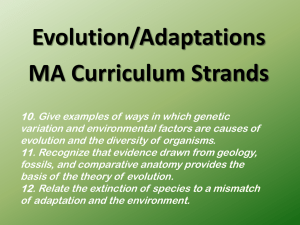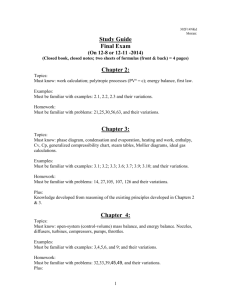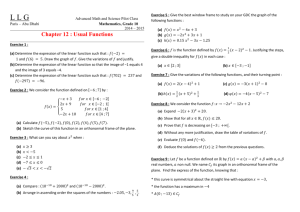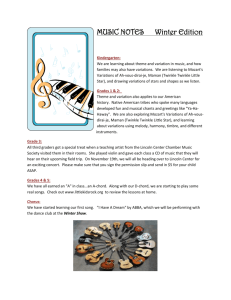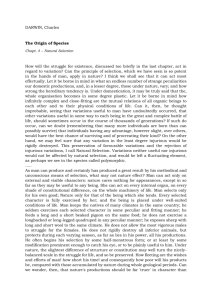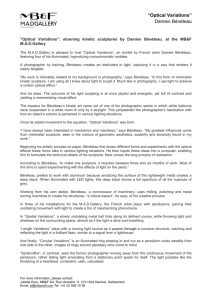Bag of Tricks Quick Reference Guide
advertisement
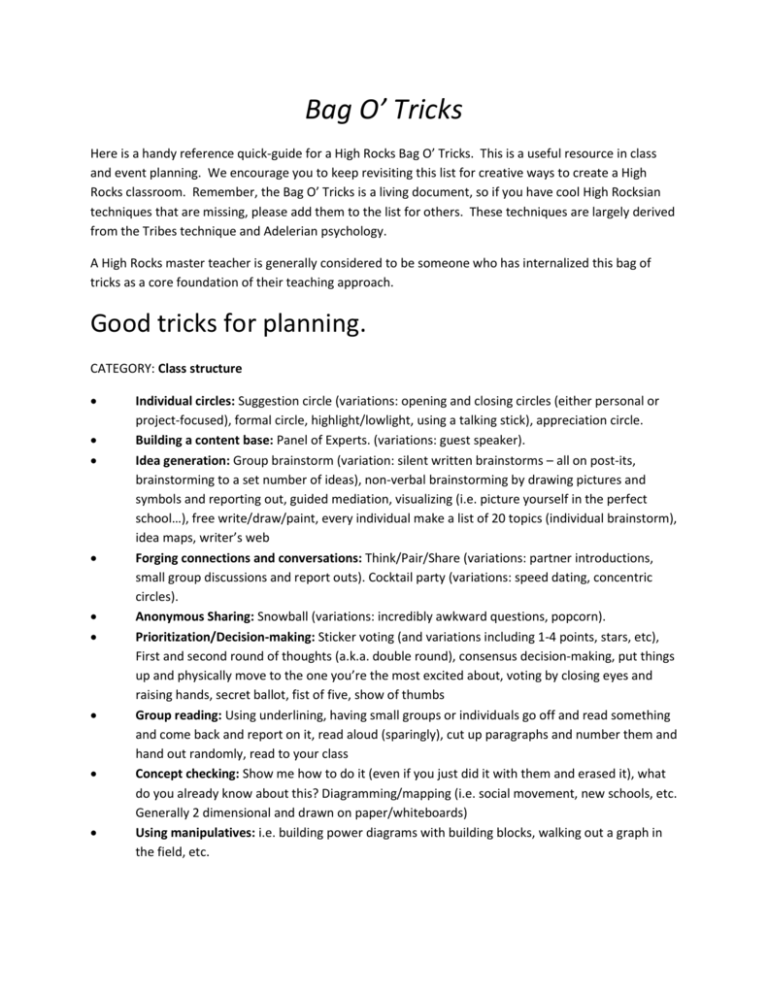
Bag O’ Tricks Here is a handy reference quick-guide for a High Rocks Bag O’ Tricks. This is a useful resource in class and event planning. We encourage you to keep revisiting this list for creative ways to create a High Rocks classroom. Remember, the Bag O’ Tricks is a living document, so if you have cool High Rocksian techniques that are missing, please add them to the list for others. These techniques are largely derived from the Tribes technique and Adelerian psychology. A High Rocks master teacher is generally considered to be someone who has internalized this bag of tricks as a core foundation of their teaching approach. Good tricks for planning. CATEGORY: Class structure Individual circles: Suggestion circle (variations: opening and closing circles (either personal or project-focused), formal circle, highlight/lowlight, using a talking stick), appreciation circle. Building a content base: Panel of Experts. (variations: guest speaker). Idea generation: Group brainstorm (variation: silent written brainstorms – all on post-its, brainstorming to a set number of ideas), non-verbal brainstorming by drawing pictures and symbols and reporting out, guided mediation, visualizing (i.e. picture yourself in the perfect school…), free write/draw/paint, every individual make a list of 20 topics (individual brainstorm), idea maps, writer’s web Forging connections and conversations: Think/Pair/Share (variations: partner introductions, small group discussions and report outs). Cocktail party (variations: speed dating, concentric circles). Anonymous Sharing: Snowball (variations: incredibly awkward questions, popcorn). Prioritization/Decision-making: Sticker voting (and variations including 1-4 points, stars, etc), First and second round of thoughts (a.k.a. double round), consensus decision-making, put things up and physically move to the one you’re the most excited about, voting by closing eyes and raising hands, secret ballot, fist of five, show of thumbs Group reading: Using underlining, having small groups or individuals go off and read something and come back and report on it, read aloud (sparingly), cut up paragraphs and number them and hand out randomly, read to your class Concept checking: Show me how to do it (even if you just did it with them and erased it), what do you already know about this? Diagramming/mapping (i.e. social movement, new schools, etc. Generally 2 dimensional and drawn on paper/whiteboards) Using manipulatives: i.e. building power diagrams with building blocks, walking out a graph in the field, etc. CATEGORY: Class management Set the tone: Group agreements, icebreakers, breaks, prizes, sparkle, etc. Leadership opportunities: Roles/Jobs (recorder of discussion, timekeeper, be in charge of breaking people into groups, being in charge of the whiteboard, etc), Move on the agenda: Timekeeping, time limits, giving set time limits with warning finger and clapping at end of time. Randomization: Scramble, musical chairs, assigning tables by color/shapes, count-offs, partner with someone you don’t know that well Make sure everyone speaks: using formal structures, making sure everyone’s voice is heard, asking to hear from people who haven’t shared yet, respecting the right to pass Ask good questions: Reflective listening, “that’s good – tell me more about that,” “unpack that,” “isn’t it interesting that,” role-playing, hosting a debate, relating concepts to each other, not being scared of silent wait time (aka don’t answer your own questions), relating ideas or concepts to their personal experience Quiet your class: clap once, putting people on “mute,” chirp like a cricket if you can hear me, Preserving thinking space: hand on head (and limitless variations), writing before anyone talks (both quick notecard and 5 min free-write), send people on a walk, giving breaks, calling out sidebars, reel-it-in pantomime or other secret hand signals you make up with your class Teach students how to act: Don’t be afraid to actively and explicitly teach your students what a productive student looks like (head up, eye contact, volunteerism, preparedness, enthusiasm). Par Praise quality of effort: Focus on how much effort and practice a student puts into their work instead of praising their natural abilities. Anyone can learn to be a musician or a mathematician. Work ethic is the number-one factor that will help your students succeed. Disengage with power struggles: Side-step, change the subject, check your own emotional response, present clear choices and consequences,



